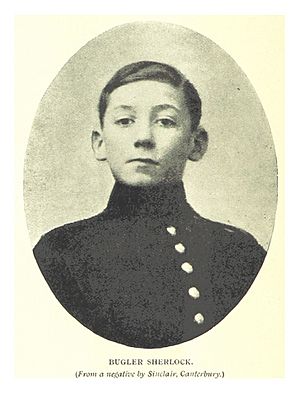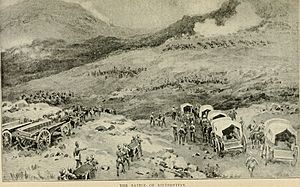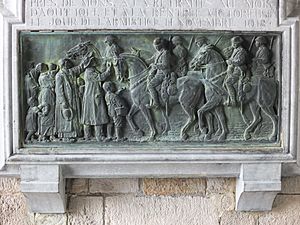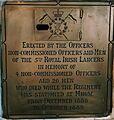5th Royal Irish Lancers facts for kids
Quick facts for kids 5th Royal Irish Lancers |
|
|---|---|
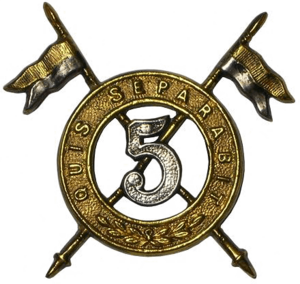
Badge of the 5th (Royal Irish) Lancers
|
|
| Active | 1689–1799 1858–1922 |
| Country | |
| Branch | |
| Type | Cavalry |
| Role | Line Cavalry |
| Size | 1 Regiment |
| Nickname(s) | The Redbreasts |
| Motto(s) | Quis separabit (Who shall separate us?) |
| March | Slow: Let Erin Remember, The Harp That Once Through Tara's Halls |
| Commanders | |
| Notable commanders |
Field Marshal Richard Molesworth, 3rd Viscount Molesworth General Joseph Yorke, 1st Baron Dover |
The 5th Royal Irish Lancers was a famous cavalry regiment in the British Army. Cavalry means soldiers who fought on horseback. This regiment served for over 300 years, including in the First World War. In 1922, it joined with another regiment, the 16th The Queen's Lancers, to form the 16th/5th Lancers.
Contents
A Long History of Service
Early Battles and Renaming
The regiment started in 1689 as James Wynne's Regiment of Dragoons. Dragoons were soldiers who could fight on horseback or on foot. They fought in important battles like the Battle of the Boyne in July 1690 and the Battle of Aughrim later that month. These battles were part of a war led by King William III.
In 1704, the regiment changed its name to the Royal Dragoons of Ireland. They fought bravely under the Duke of Marlborough at the Battle of Blenheim in August 1704. This battle was part of the War of the Spanish Succession. They also helped capture a whole French regiment at the Battle of Ramillies in May 1706. Later, they fought at the Battle of Oudenarde in July 1708 and the Battle of Malplaquet in September 1709.
Becoming Lancers and Serving Abroad
In 1751, the regiment was renamed the 5th Regiment of Dragoons. Then, in 1756, it became the 5th (or Royal Irish) Regiment of Dragoons. They served in Ireland and even led a charge against rebels at the Battle of Enniscorthy in May 1798 during the Irish Rebellion of 1798.
After this, the regiment faced a difficult time and was disbanded in 1799. However, it was brought back in 1858, keeping its old number and name. It was then changed into a lancer regiment, meaning its soldiers used long spears called lances. It was first called the 5th (or Royal Irish) Regiment of Dragoons (Lancers) and later simply the 5th (Royal Irish) Lancers.
The regiment served in India from 1863 to 1874. A group of its soldiers also joined the Nile Expedition in 1884. They fought against forces led by Osman Digna near Suakin in 1885 during the Mahdist War. The regiment returned to India in 1888 for ten years. In 1898, they moved to South Africa, staying in Ladysmith and Pietermaritzburg before the Second Boer War began in October 1899.
Fighting in the Second Boer War
The 5th Royal Irish Lancers were one of only two cavalry regiments in South Africa when the war started. This meant they were quickly involved in the early fighting. They fought at the Battle of Elandslaagte on October 21, 1899, and at the Battle of Rietfontein on October 24, 1899.
They were also part of the soldiers trapped inside Ladysmith during the Siege of Ladysmith, which lasted from November 1899 to February 1900. After the siege ended, they got new horses and joined General Sir Redvers Buller's army. They took part in many battles with him.
The regiment stayed in South Africa until the war ended on May 31, 1902. After the war, 340 officers and men sailed back to Southampton in October 1902.
The First World War and Beyond
Before the First World War, the regiment was in England. When the war began in August 1914, they became part of the British Expeditionary Force. They sailed from Dublin to France to fight on the Western Front. They saw action during the Battle of Mons in August 1914.
During the Battle of Cambrai in November 1917, a soldier named George William Burdett Clare received the Victoria Cross, the highest award for bravery, after he died in battle. The 5th (Royal Irish) Lancers also have the sad distinction of having the last British soldier to die in the Great War. This was Private George Edwin Ellison, who was killed by a sniper just before the war officially ended on November 11, 1918, as the regiment advanced into Mons.
The regiment was renamed the 5th Royal Irish Lancers and was disbanded in 1921. However, a part of it was brought back in 1922. It immediately joined with the 16th The Queen's Lancers to create a new regiment called the 16th/5th Lancers.
Regimental Museum
You can learn more about the 5th Royal Irish Lancers at The Royal Lancers and Nottinghamshire Yeomanry Museum. This museum is located at Thoresby Hall in Nottinghamshire.
Battle Honours
The regiment earned many special awards called Battle Honours for their bravery in different wars. These honours are like badges of courage for their service:
- Early Wars: Blenheim, Ramillies, Oudenarde, Malplaquet, Suakin 1885, Defence of Ladysmith, South Africa 1899–1902
- The Great War: Mons, Le Cateau, Retreat from Mons, Marne 1914, Aisne 1914, Messines 1914, Ypres 1914, 1915, Gheluvelt, St. Julien, Bellewaarde, Arras 1917, Scarpe 1917, Cambrai 1917, Somme 1918, St. Quentin, Amiens, Hindenburg Line, Canal du Nord, Pursuit to Mons, France and Flanders 1914–18
Victoria Crosses Awarded
Two brave soldiers from the 5th Royal Irish Lancers received the Victoria Cross:
- Private George William Burdett Clare - for his actions during the First World War on November 28–29, 1917.
- Lieutenant Frederic Brooks Dugdale - for his bravery during the Second Boer War on March 3, 1901.
Images for kids
See also


